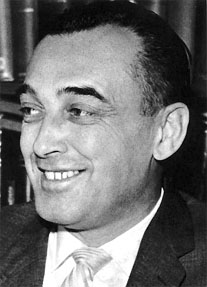van Vogt, A(lfred) E(lton) (1912–2000)

A. E van Vogt was a Canadian-born American writer who began writing science fiction for John W. Campbell's Astounding in 1939 and became a prominent figure of Campbell's Golden Age. Some of his early work was done in collaboration with his first wife, E. Mayne Hull (1905–1975).
Van Vogt's first story "Black Destroyer" (1939; subsequently built into The Voyage of the Space Beagle, 1950), features the first of many memorable alien beings involved in a contest for survival with human explorers. His first novel, Slan (1940/1947; revised 1951), introduces what was to become his foremost preoccupation: its central character has latent superhuman powers that explode into awesome potency under the pressure of harassment and threat. This key image recurs constantly in van Vogt's work, providing his tense plots with spectacular climaxes.
He was much given to convoluted and tangled story lines – his natural imaginative fertility was supplemented by the technique of binding several distinct short pieces into what he calls "fix-up" novels – and these usually require resolutions that are literary analogues of Alexander's cutting of the Gordian knot. Critics of his work charged him with failing to make sense in deploying his complex and disparate materials, but enthusiasts loved the grandiosity of his schemes and the panache of his imaginative flourishes.
Van Vogt played a key role in helping to develop the Galactic Empire scenario, which in turn played a key role in liberating the imaginative potential of American SF. His stories collected as the novel The Weapon Shops of Isher (1941/1942–1949/51) and its sequel The Weapon Makers (1943/1946; revised 1952) feature an imperial government on the Earth opposed by the Liberterian Weapon Shops. Another collection novel, Empire of the Atom (1946–1947/1956), and its sequel The Wizard of Linn (1950/1962) transpose aspects of the history of the Roman Empire into a future galactic culture somewhat after the fashion of Isaac Asimov's Foundation series. The World of Null-A (1945/1948) and The Pawns of Null-A (1948–1949/1956); also known as The Players of Null-A) – his most celebrated, confusing, and effective work of the Golden Age period – similarly expand their action to a grand galactic scale, this time pitting a stultified and militaristic political order against a superhuman champion of "non-Aristotelian logic."
The imaginative inspiration for these novels came from Alfred Korzybski's theory of general semantics, the first of several pseudoscientific vogues in which Campbell and his disciples were to become interested. Van Vogt was later recruited to the cause of the most notorious of these adventures in scientific unorthodoxy, L. Ron Hubbard's Dianetics, which promised to show how people can take control of their supposed later superhumanity after the fashion of so many of van Vogtian heroes.
After a long hiatus in his career, van Vogt returned to SF writing in the late 1960s and published fairly prolifically in the 1970s. His most important works of this period are The Battle of Forever (1971), whose typically superhuman hero matures in baroque far future settings, and The Anarchistic Colossus (1977), which further develops his interest in hypothetical Libertarian social systems. In many of his later novels, including the third Null-A novel, Null-A Three (1985), he was content to provide ritual reenactments of his standard themes, but he continued to develop new hypotheses, including some ideas about female psychology, displayed in The Secret Galactics (1974, also known as Earth Factor X) and elsewhere. Despite the flamboyance of his work, he was not a careless writer; van Vogt's power lies in conjuring up striking and powerful images, which have captivated many fans and influenced many later writers, most obviously Charles L. Harness and Ian Wallace.
Notable other works
The Book of Ptath (1943/1947); Out of the Unknown (with E. Mayne Hull, 1948); Masters of Time (1950; includes "Recruiting Station," 1942, also known as Earth's Last Fortress); The House That Stood Still (1950, also known as The Mating Cry and The Undercover Aliens); The Mixed Men (1952); Destination: Universe! (1952); Away and Beyond (1952); The Universe Maker ("The Shadow Men" 1949/1953); The Mind Cage (1957); The War Against the Rull (1959); Siege of the Unseen ("The Chronicler" 1946/1959, also known as The Three Eyes of Evil); The Beast (1963, also known as Moonbeast); The Twisted Men 91964); Rogue Ship (1965); The Winged Man (with E. Mayne Hull, 1944/1966); The Silkie (1969); Quest for the Future (1970); Children of Tomorrow (1970); More Than Superhuman (1971); The Darkness on Diamondia (1972); The Book of van Vogt (collection, 1972, also known as Lost: Fifty Suns); Future Glitter (1973, also known as Tyranopolis); The Man with a Thousand Names (1974); Supermind (1977); Pendulum (1978); Renaissance (1979); Cosmic Encounter (1980); Computerworld (1983, also known as Computer Eye).
Source: The New Encyclopedia of Science Fiction, ed. James Gunn


